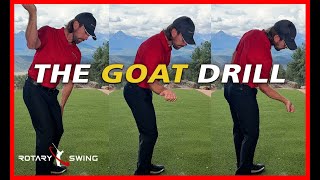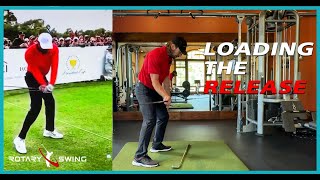If you are confused about the correct golf stance width, you are not alone.
Determining the proper golf stance width is one of those things in golf instruction that there’s a lot of conflicting information on.
You've certainly heard all of these before from various golf instructors:
- Stand really wide so you can be really stable.
- Stand really narrow so you can rotate better.
- Stand with your feet shoulder width apart like you do in other sports.
All these recommendations are misinformation even though the intentions may be good.
Your Anatomy Determines the Right Golf Stance for YOU
The setup width should be based on the fundamentals of your anatomy and the fundamentals of what you’re trying to achieve in the golf swing.
Your shoulders have nothing to do with your golf stance width unless your legs (and you may be different than me) are attached to your shoulders.
I’ll assume they’re not, so that means your shoulders have no bearing on how wide your stance should be. None whatsoever.
Everybody’s shoulder width and hip width is completely different. Everybody’s ratio, how wide their hips are versus how wide their shoulders are, is completely different.
You need to be looking at your hips, specifically the sockets where your legs attach, to determine your stance width. So there’s an anatomical basis for your stance width.

Get Stance Width Right for Stability and Safety
The first thing you’re trying to achieve is stability. You can’t stand super narrow because you’re not going to have any stability; you won’t have a good foundation.
Your other goal with determing proper golf stance width has to do with impact. The most important part of the golf swing is getting perfectly stacked on the left side at impact so that you can rotate freely.
This is where some of the highest forces in the golf swing occur on your body, on this left side coming in the downswing and into impact. And so this is where a lot of injuries occur.
You don’t see a lot of injuries happening during the golf backswing because there’s not as much force and speed happening.
But the downswing can cause issues such as back problems, hip problems, and knee problems. We can look at the player's stance width and the way his body is moving and say, "Well, yeah, that’s part of the reason why it’s happening."
Having the proper stance width is imperative for reducing injury. So, let’s figure out what the proper stance width is from an anatomical perspective and how you determine that.
How to Find Your Correct Golf Stance Width
To be honest, it’s pretty hard to get 100% perfect unless you have an x-ray machine, so you’re going to have to use a little bit of guesstimation here to get really close.
Basically, what you need to do is find neutral joint alignment. In other words, find where the center of your ankles, center of your knees, and center of your hips stack up over each other.
Obviously you can’t see the center of your hips very well. The knees are pretty easy, but you can kind of figure out where the center of your hips are based on feeling your hip bones and moving an inch and a half or so inside.
That’s a really rough estimate because some people’s hip bones are going to be out further than others. I’m just trying to give you a rough guide here.
The more important guide is for you to feel where neutral is for you. Neutral for me is when my legs are basically straight up and down, underneath my hips.
Now, what I can do is I can go a couple inches on either side of neutral, and this is going to allow me to have a stable enough base, so as I rotate back, I’m going to have stability.
And, as I rotate through, I’m going to have stability in the downswing. This will make it much easier for me to get to my left side in the downswing, and that’s the most important part.
If I can get onto my left in my downswing, and pivot properly on my hip, then I have a stance that’s going to work.

Why a Wide Golf Stance Width Will Fail You
For comparison's sake, if I stand really wide, for me to load up my right side of my backswing, I’m going to have to move my head off of the ball. Since you’re trying to rotate around your spine, that’s not going to help you.
If I stand really wide and don’t move my head, then I never shift my weight, which means I’m missing the added benefit of the power that comes from the weight transfer.
Also, if my stance is too wide, I have to move a long ways to get my hip back into neutral. And since the downswing happens so fast, it’s really hard for you to do that.
Summary
So what we want is a stance that has our ankles a couple inches outside of neutral.
That’ll allow me to stay stable, shift my weight on the backswing, shift my weight really easily on the downswing (getting into neutral), and rotate through and still be in balance.
What we’re trying to achieve is a narrow enough stance that we easily get back to the left in the downswing, and a wide enough stance that we have stability and power.
For most golfers, a couple inches outside of neutral will allow you to make a proper weight transfer and get back to the left side on the downswing.
Now get up and try it for yourself!
Watch part 2 now to see how you're moving your body in the opposite direction of the pros!
































































































































































































































































































































































































































































































